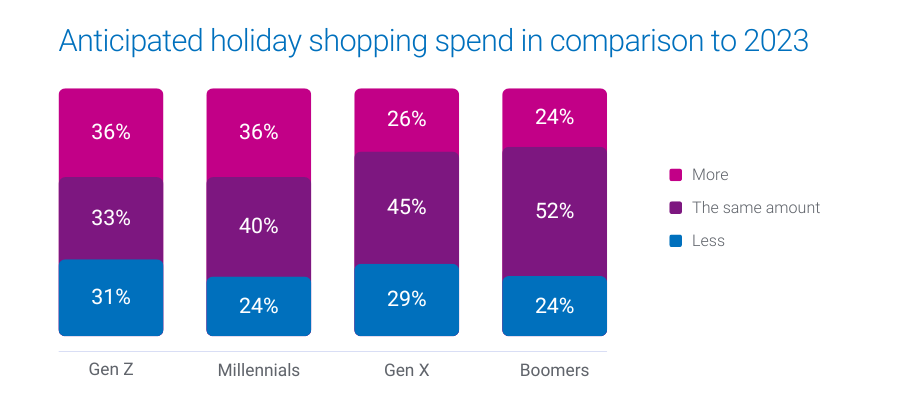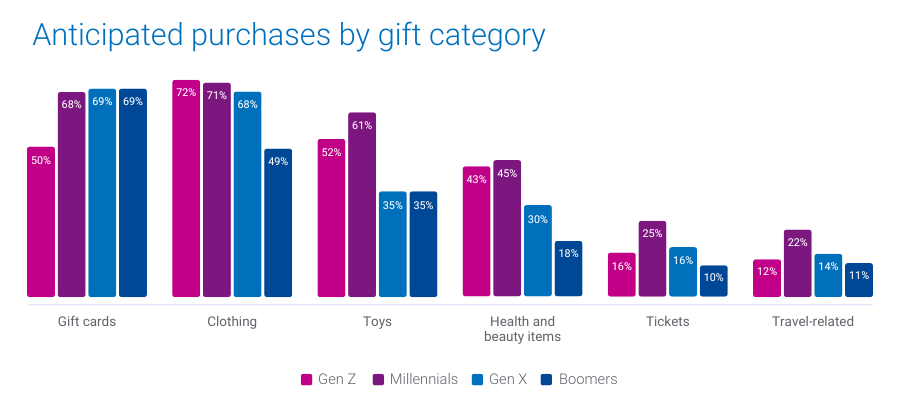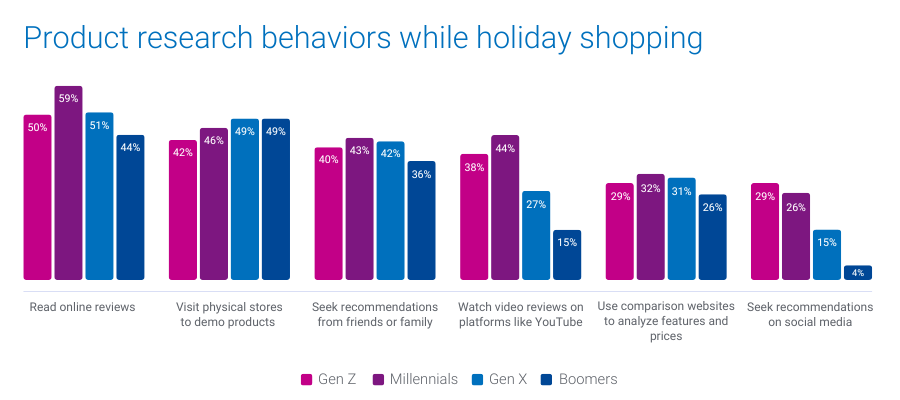
The holiday season is almost here, and knowing how each generation plans to shop can give your holiday advertising campaigns the edge you need. Our recent survey of 1,000 U.S. consumers reveals 2024 holiday shopping trends for each generation and key insights into their anticipated spending levels, preferred shopping categories, and how they look for gift ideas.
In this blog post, we’ll explore three 2024 holiday shopping trends across generations:
- Projected consumer spending
- Top categories on shoppers’ lists
- Preferred channels for researching gifts
1. Projected consumer spending
Over 1 in 3 Gen Z and Millennials are gearing up to increase their holiday budgets this year, while Gen X and Boomers are likelier to stick to last year’s budget.
- 36% of Millennials and Gen Z plan to spend more this holiday season
- 45% of Gen X and 52% of Boomers expect their spending to remain consistent with last year

What this means for marketers
These insights highlight the importance of tailoring your messaging. For Gen Z and Millennials, emphasize value and unique offerings that justify increased spending. For Gen X and Boomers, focus on trust and reliability, reinforcing their confidence in your brand.
How Experian can help you target these audiences
Experian’s custom and syndicated audience segments, including Holiday Shopper High Spenders and Holiday Shopper Moderate Spenders, enable you to connect with these diverse consumer groups. Our audiences are available on-the-shelf of leading ad platforms to help you reach people across social, TV, and mobile.
The election effect
U.S. holiday retail sales saw 4.1% YoY growth in 2016 and 8.3% YoY growth in 2020 following presidential elections. There’s a chance that holiday spending increases after the 2024 election, regardless of the outcome. Experian has 240+ politically relevant audiences that you can activate across major ad platforms ahead of the upcoming election.
2. Top categories on shoppers’ lists
Different generations have distinct preferences when it comes to what they plan to buy. Gift cards top the list for Gen X and Boomers, while Gen Z leans toward clothing. Millennials are looking to splurge on toys, electronics, and experiences.
- 69% of Boomers and Gen X plan to purchase gift cards
- 72% of Gen Z will buy clothing
- 45% of Millennials will buy health and beauty items
- 25% of Millennials will buy tickets and 22% of Millennials will buy experiences

What this means for marketers
Align your product offerings and promotions with each generation’s preferences to capture their attention. For example, highlighting versatile gift cards may resonate more with older generations, while showcasing trendy apparel and tech gadgets will appeal to younger consumers.
How Experian can help you target these shoppers
We offer audience segments like Holiday Shoppers: Apparel, Cosmetics & Beauty Spenders, and Toys Shoppers that you can activate to connect with consumers primed to purchase in these categories.
We recently released 19 new holiday shopping audiences we recommend targeting to drive engagement and conversions. Download our audience recommendations here.
3. Preferred channels for researching gift ideas
When it comes to finding the perfect gifts, Gen Z turns to social media, while Millennials prefer online reviews and video content. Boomers and Gen X are more inclined to visit physical stores for hands-on product evaluations.
- 29% of Gen Z and 26% of Millennials will look for gift ideas on social media
- 44% of Millennials will rely on video reviews and product demos on platforms like YouTube
- 49% of Gen X and Boomers plan to visit physical stores to evaluate products in person

What this means for marketers
Understanding where each generation looks for inspiration can guide your content and ad placement strategy. To engage Gen Z, focus on social media campaigns and influencer partnerships. For Millennials, consider investing in video content and reviews. For older generations, ensure your in-store experience is optimized to convert browsing into purchases.
How Experian can help you engage these shoppers
Our TrueTouchTM audiences can help you pair the perfect messaging styles with the right channels and calls to action. Our Social media channel and content engagement audiences can help you reach Gen Z who are likely to be active users on major social platforms and are Black Friday shoppers. For a full list of Experian’s syndicated audiences and activation destinations, download our syndicated audiences guide.
Download our report for five 2024 holiday shopping trends by generation
Understanding 2024 holiday shopping trends by generation can help you tailor your targeting, messaging, media planning, and creative based on the generation you’re targeting.
In addition to the insights covered here, download our 2024 Holiday spending trends and insights report to learn:
- When consumers plan to shop (hint: they’re already shopping)
- Where they plan to shop (online vs. in-store)
Download our full report to access all five of our predictions by generation, so you can address the diverse needs of this year’s holiday shoppers.
When you work with Experian for your holiday shopping campaigns, you’re getting:
- Accurate consumer insights: Better understand your customers’ behavioral and demographic attributes with our #1 ranked data covering the full U.S. population.
- Signal-agnostic identity solutions: Our deep understanding of people in the offline and digital worlds provides you with a persistent linkage of personally identifiable information (PII) data and digital IDs, ensuring you accurate cross-device targeting, addressability and measurement.
- Secure connectivity: Bring data and identity to life in a way that meets your needs by securely sharing data between partners, utilizing the integrations we have across the ecosystem, and using our marketing data in flexible ways.
Make the most of this holiday shopping season with Experian. Contact us today to get started.
Source
Online survey conducted in June, 2024 among n=1,000 U.S. adults 18+. Sample balanced to look like the general population on key demographics (age, gender, household income, ethnicity, and region).
Latest posts

Public attitudes are more open and accepting of LGBT Americans today, and marketers are increasingly showing their support of their LGBT customers. Experian Simmons includes a measure of sexual orientation among non-Hispanic respondents of our National Consumer Study, the only known large probability sample syndicated study to include such a measure. In our 2012 LGBT Demographic Report, we looked at marriage and cohabitation habits, as well as income levels and discretionary spend of LGBT and heterosexual adults alike. This data helps marketers better understand and connect to the growing and already influential LGBT demographic and to benchmark important factors against the heterosexual population. A look into individual earnings and household incomes shows that lesbian women earn more than heterosexual women regardless of relationship status. Specifically, the typical adult lesbian woman personally earns $43,100 per year compared with $37,600 claimed by the average heterosexual woman. Furthermore, the typical household income of a married or partnered lesbian woman is $7,200 higher than that of a married or partnered heterosexual woman. Mean individual earnings and household income of women, by sexual orientation When it comes to individual income, gay and straight men may earn roughly the same amount, but married or partnered gay men personally take home nearly $8,000 more, on average, than their straight counterparts. Additionally, the average household income of a married or partnered gay man is $116,000 versus $94,500 for a straight married or partnered man. Mean individual earnings and household income of men, by sexual orientation Income levels are important to consider when targeting consumers, but more important is determining the amount of money they have left over after the bills are paid for non-essentials. Despite having higher incomes, some may be surprised to learn that lesbian women have only the same amount as heterosexual women to spend on discretionary items. Likewise, gay men have less than heterosexual men for non-essentials overall, even though their incomes overall are quite equal. This is mostly likely due to the fact that both lesbian and gay adults tend to reside in larger cities where the cost of living can be considerably higher. Interestingly though, when household size is brought into the equation, we see that gay males actually have more to spend on non-essentials per capita than straight men. Gay men, for instance, live in households that spend $6,256 per capita annually on discretionary spending, nearly $1,000 more than what the households of heterosexual men spend per person. For more demographic and attitudinal information on the trends among the LGBT population, download the 2012 Lesbian, Gay, Bisexual, Transgendered Demographic Report.

My Experian Marketing Services’ colleagues and resident data experts Bill Tancer and Marcus Tewskbury answered the above question for marketers during our recent 2012 Holiday Planning Webinar. The webinar recapped key 2011 holiday marketing results, plus featured trends, benchmarks and recommendations for a successful and profitable 2012 holiday shopping season. Here are a few cool facts: For the first time, last year’s Cyber Monday beat Thanksgiving Day as the busiest online shopping day of the year Facebook and Pinterest were the top traffic sources to the Experian Marketing Services Retail 500 Pinterest visitors most often went to etsy.com and amazon.com from the pinterest.com site Dynamic content in emails can drive up to a 70% lift in open rates Tying web, email and in-store promotions together enhances the shopping experience and improves sales The bottom line is that marketers need to understand where there customers are, when they are there, and what they are doing. Armed with that knowledge, you can deliver personalized and targeted holiday messages that are sure to make this shopping season merry and bright (and profitable!). View the webinar to learn more.

Even though most kids haven’t even completed their current school year, now is the time for retailers to start preparing their 2012-2013 back-to-school marketing strategies. I remember growing up as a kid in rural Massachusetts thinking about how “back-to-school” TV ads were so irritating. Back-to-school? In July? I’m not even half way through my summer vacation! Little did I know back then that marketers like to get an early start to the back-to-school sales season by planting seeds with their target audience and hoping those seeds grow into a healthy crop of new customers. This remains true today and planting season starts even earlier. The back-to-school sales season represents a huge opportunity for marketers. Here are some facts and figures that help quantify the size of the market: According to the National Retail Federation, consumers will spend approximately $70 billion on back-to-school merchandise. About $23 billion of this is spending by parents of children in kindergarten through 12th grade. The remainder represents spending by students starting or returning to college. All told, the back-to-school season is the second largest consumer spending event for retailers outside of the winter holidays. According to the U.S. Census Bureau, this year there will be over 55 million students enrolled in schools from pre-kindergarten through high school. About 56% of these students are in grades one through eight, 28% are in high school and 15% are enrolled in preschool or kindergarten. About one-third of households contain children under age 18. That translates to roughly 38 million households. The vast majority of these contain school-age children. The back-to-school season is not just about reaching kids in elementary school, middle school, junior high school and high school. Another 20 million students are expected to be attending college. That’s a huge opportunity to sell things like dorm room furnishings, electronic gadgets and computers, just to name a few. With every marketing opportunity come certain marketing challenges. It’s never easy. Marketers of back-to-school products face their own set of challenges when vying for the attention of parents of school-age children. Here are some specific examples: Who are my key targets and how can I differentiate my marketing message? Targeting a market that includes a vast array of families with contrasting attitudes, opinions, motivations, lifestyles and shopping behaviors is incredibly challenging. Not all of these families are working from the same shopping list. And not all of these families will respond to the same marketing message. Segmenting your market into finer target audiences is highly recommended. How should my marketing budget be allocated across multiple online and offline channels? You have multiple sales and marketing channels to consider. You don’t want to build a marketing plan without a well-defined strategy for reaching your best targets. For instance, moms have a greater propensity to have a smartphone compared to the overall adult population. Thus, marketers should then be thinking about integrating mobile applications into their overall strategy. What can I do to make my message stand out above the crowd? Put yourself in the consumer’s shoes. I’m sure some of you are parents with children in school or in college. It’s a very crowded and cluttered back-to-school marketplace with many, many retailers clamoring for attention. One idea for standing above the crowd is to start by identifying your existing customers who are most likely to have families with children. Then send them an email early in the summer with suggestions for fun things to do this summer season. This can be followed up later with an email campaign containing some tips about getting ready for back-to-school. The key is to grab their attention and start engaging early. What variety of offers and promotions will enable me to capture a significant share of back-to-school expenditures? To capture your fair share of the back-to-school market you’ll need to develop offers and promotions that are both enticing and relevant. This requires learning as much as you can about your prospects and what motivates them to buy. For instance, a typical mom with elementary school-age children might enter the back-to-school season with the following thoughts: “I want to buy him the cool gear to go back to school with: new clothes, shoes, backpack and lunch box. And I don’t mind, I actually LOVE back to school shopping.”* That mom may quickly respond to your marketing message. Or, you could have a mom with these thoughts: “I’m not upper class – we’re in the lower/middle income bracket and money is tight for us. I budget for school expenses as I would anything else…and I won’t have my son miss out because ‘we can’t afford’ something… I’d give up something else first.”* She loves shopping for back-to-school, she has budget limitations, and she’s willing to make certain adjustments to her budget with the best interests of her child in mind. If you knew what she was most likely to be thinking, do you think it would influence the messaging and offers you would use to attract her? Well, of course. Attitudes shape shopping behavior. ___________________________________________________________________________________ Watch our recent webinar about planning your back-to-school marketing campaigns in style. And stay tuned for part two of my blog series on the topic in a few days. *Feedback was compiled from PHD in Parenting: http://www.phdinparenting.com/2011/08/22/who-should-pay-for-school-supplies/